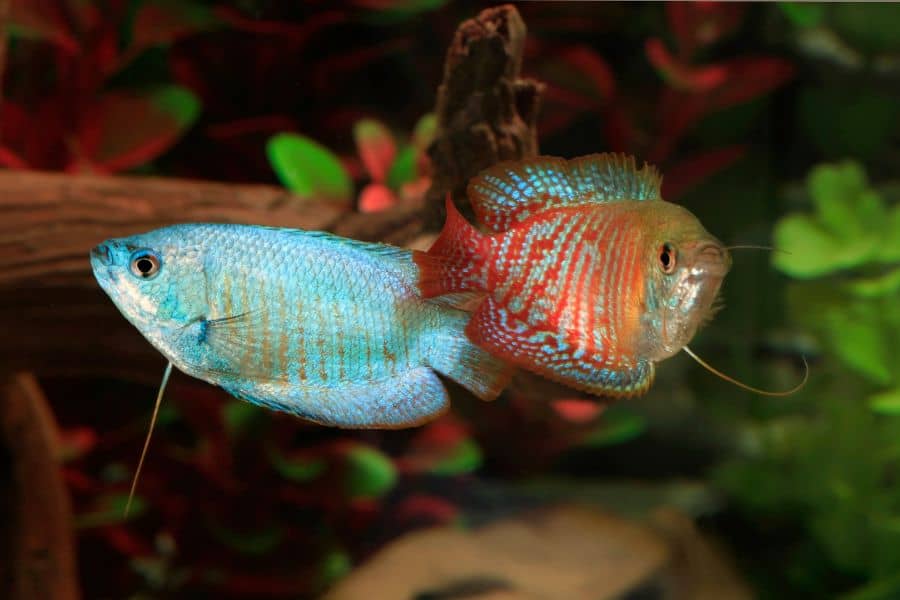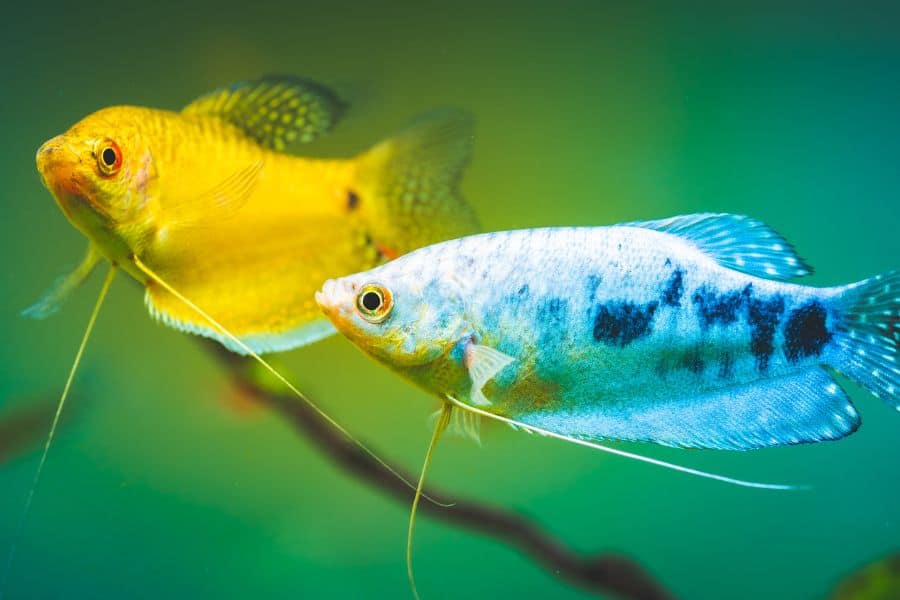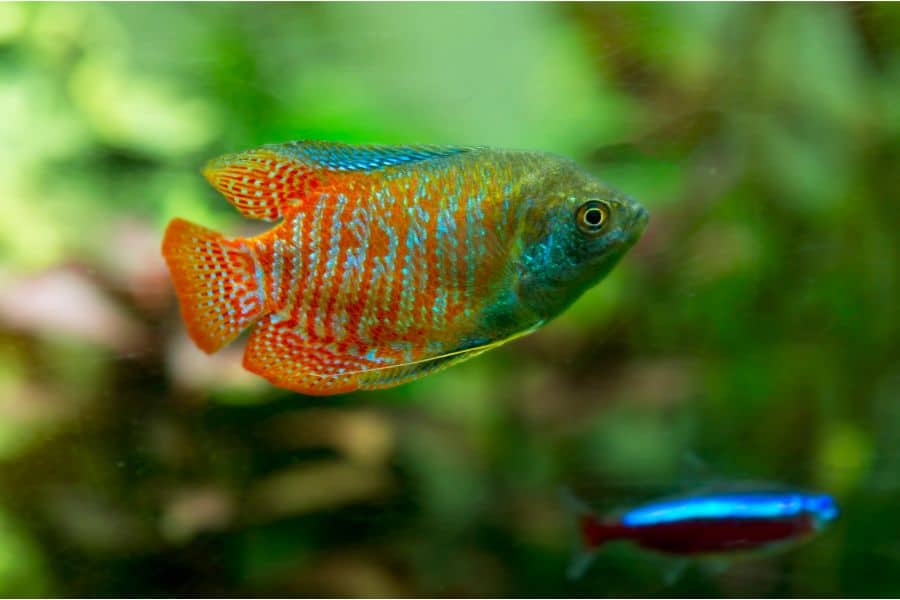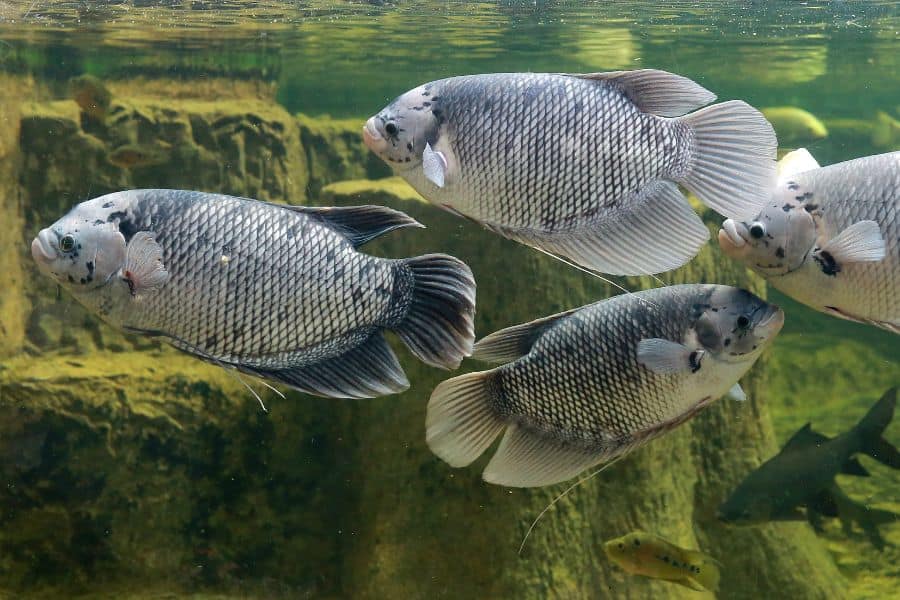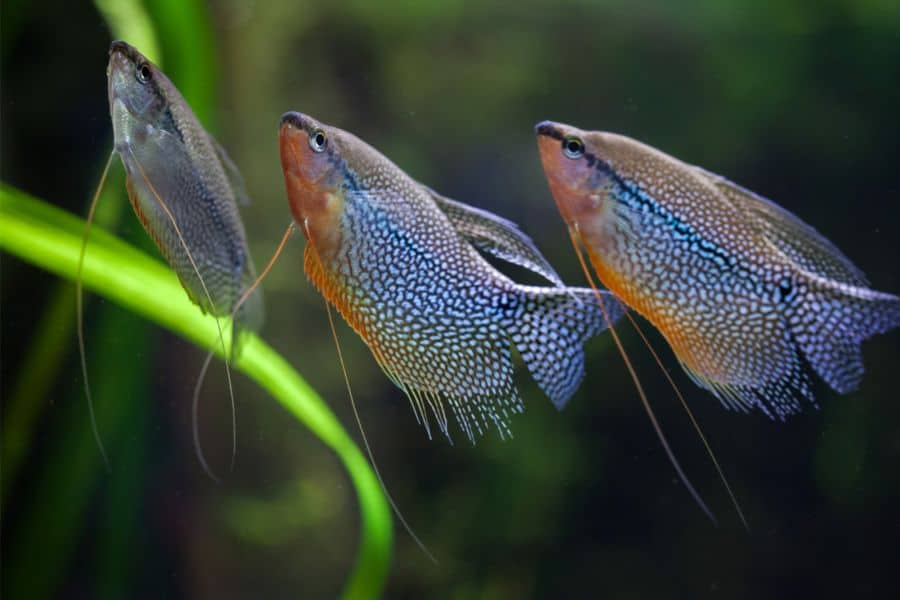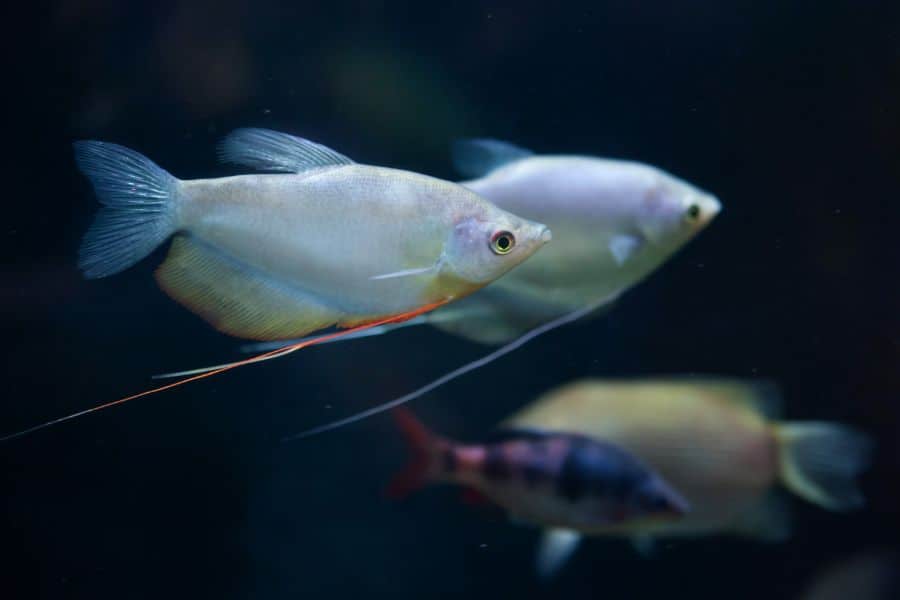The gourami fish is ranked among the most popular aquarium species in the world. Gourami comes second after the much more popular bettas, goldfish, guppies, molly, tetras, platy, and angelfish.
The popularity is due to the species’ wide range of beautiful hardy fish with over 90 variants.
Colors are plenty, including the three-spot variants, chocolate, and sparkling gourami. What about the size? You have the dwarf gourami species if you are looking for a gourami that is easiest to care for; otherwise, you can opt for the giant gourami species featuring massive fish that span past 24 inches.
Read on to get to know all about the gourami types of fish you can easily buy today and which ones fit into your specific aquarium. Learn their different features and how they stand out from one another.
What Are Gourami Fish? A Brief Overview
The gourami fishes, scientifically known as Osphronemidae, are a wide selection of over 90 types of fish. They are distinctively characterized by an elongated feeler-like ray in each pelvic fin, labyrinth organs that help them breathe air, and parental care until their fry swims freely.
Classification of The Gourami Fish Types:
| Kingdom | Animalia |
| Phylum | Chordata |
| Class | Actinopterygii |
| Order | Anabantiformes |
| Family | Osphronemidae (Gourami is also used to refer to some fish under Helostomatidae in the order Perciformes) |
| Subfamilies | – Belontiinae – a genus of medium to giant large-sized gourami
– Osphroneminae – genus of giant gouramies – Luciocephalinae – Macropodusinae – Trichogastrinae – most gourami species belong to this group, specifically the trichogaster genus |
Every species in the gourami category originates from Asia including Korea, Pakistan, Indonesia, India, and other parts of Southeast Asia. Their natural habitat consists of tropical freshwaters that are either warm, shallow, or low in oxygen concentration.
Since their natural habitat had oxygen-poor water, these types of fish evolved to have labyrinth organs making the gourami a labyrinth species.
As labyrinth fish, the gourami species breathe with their gills like other fishes but also have the labyrinth, a secondary breathing structure that helps them breathe atmospheric air.
The labyrinth is filled with blood vessels and situated above the gills; this helps the fish take in oxygen from the air into their mouth, thus into the blood vessels and throughout the body. This nifty feature makes gourami one of the few species that do not need air pumps in their aquarium tank.
Colors vary widely, including powder blue, pearl, blue, golden, sparkling, and many more. The most tip to remember about the gourami color is that males produce more vividly impressive colors when female gouramis are around.
You may also be wondering if gouramis are aggressive. To address this, it is important to note that male gourami fish can display aggression towards each other, but female gouramis do not.
The aggression can be seen in fin-nipping and fights with other tank mates. However, from a general point of view, gouramis are not aggressive in nature. It is advisable to keep male gouramis in separate tanks. Females gouramis are the most peaceful gourami for community tanks.
When it comes to lifespan, most gourami fish live up to 5 years, typically 2-3 years on average. However, this depends on the species. The giant gourami is one of the few types that can live up to 20 years in the right environment.
As for breeding, gourami types breed by egg-laying, and then the eggs are fertilized, either on the inside through mouthbrooding or on the outside through bubble nesting.
Bubble nesting is where the male creates floating layers of bubble, and the female proceeds to lay eggs on them before the male fertilizes them. On the other hand, mouthbrooding is when the female lays the eggs, then takes them into her mouth, where the male fertilizes them.
Gourami fish prices depend on the species and the region you get them from. Due to their popularity, you can get dwarf gouramis for less than $9, dwarf gouramis for $10-$15, and bigger options like the giant gourami for up to $140.
There are a lot of factors hobbyists consider when looking for the best gourami to keep. Look at the most bought options to help make a well-informed decision.
Most Popular & Common Gourami Fish Types
1. Dwarf Gourami
| Common Names | Depending on color – red, flame, powder blue gourami |
| Scientific Name | Trichogaster lalius |
| Average Adult Size | 2 – 3.5 inches |
| Lifespan | Up to 4 years |
| Minimum Tank Size | 5 gallons |
| Ideal Temperatures | 72 – 82 degrees Fahrenheit |
| Ideal pH Levels | 6.0 – 7.0 |
The Dwarf Gourami is the smallest gourami that belongs to the Trichogaster genus. Typically growing to around 2 inches in length, they have a rounded body with a pointed head and long, flowing fins.
It is native to the shallow waters of South Asia, including Bangladesh, India, and Pakistan. This fish has become a popular choice due to its striking appearance, hardy nature, and peaceful temperament. The male is more brightly colored than the female and has a more pointed dorsal fin.
Many gouramis can be mistaken for dwarf gouramis due to their size. However, dwarf gouramis are differentiated by their unique colors; males have diagonal stripes colored in alternating blues and reds, while females are silvery in color.
Males are typically more colorful than females, with vibrant blue and red hues on their bodies and fins, while females tend to be more subdued in color. Their bodies are covered in iridescent scales that reflect light, giving them a shimmering effect.
There are a few color variants that arose from selective breeding, including:
- Powder blue dwarf gourami – a dwarf gourami type with diagonal stripes colored in alternating iridescent powder blue colors and reds.
- Red dwarf gourami – it is a red & blue variant but with more vivid reds than blues
- Blue dwarf gourami – it is a red & blue variant but with more vivid blues than reds.
- Rainbow dwarf gourami – a range of colors, including shades of blue, green, and red
- Neon/neon blue dwarf gourami – it has a predominantly blue coloration with a bright, iridescent sheen that reflects light in shades of blue and purple
- Flame/ red flame dwarf gourami – bright and fiery coloration, a combination of red, orange, and yellow hues
Dwarf gouramis are peaceful and get along with similarly-sized tank mates (dwarf cichlids, neon tetras, and cardinal tetras). They prefer flake foods, freeze-dried snacks, vegetable tablets, and frozen meals.
2. Giant Gourami
| Common Names | Osphronemus goramy, true gourami, common gourami, Siamese fighting fish, Siamese gourami |
| Scientific Name | Osphronemus goramy |
| Average Adult Size | 18 – 28 inches |
| Lifespan | Typically, 2 – 5 years, up to 20 years in ideal care |
| Minimum Tank Size | 200 gallons |
| Ideal Temperatures | 68 – 80 degrees Fahrenheit |
| Ideal pH Levels | 6.5 – 8.0 |
If you were wondering what the biggest gourami is, then look no further than the giant gourami.
The giant fish is a familiar species in the group featuring an average 20-pound body characterized by a compact and oval-shaped exterior with elongated filamentous rays extending from its pelvic fins.
Like other gouramis, the fish has a laterally compressed body. This shape allows them to move more easily through dense aquatic vegetation often found in their natural habitats.
The head is large and slightly flattened, with a relatively small mouth that is located on the underside of the head. Giant gouramis have long dorsal fins that can be raised and lowered with elaborate and colorful finnage, especially among males.
They can eat meaty foods but gravitate towards a herbivorous diet, feeding on a variety of plant matter, algae, and occasionally small crustaceans or insects. In captivity, they can be fed a diet of pellets, flakes, and fresh vegetables.
Despite their large size, they are generally peaceful fish but can become territorial during the breeding season. They are also relatively hardy and can tolerate a range of water conditions.
3. Pearl Gourami
| Common Names | Mosaic gourami, diamond gourami, or lace gourami |
| Scientific Name | Trichopodus leerii |
| Average Adult Size | Up to 4 inches |
| Lifespan | 4 – 5 years |
| Minimum Tank Size | 20 gallons |
| Ideal Temperatures | 75 – 82 degrees Fahrenheit |
| Ideal pH Levels | 6.0 – 7.5 |
The Pearl Gourami has a distinctive appearance, with a pearlescent body that is covered in small iridescent scales that give it a shimmery appearance. The body is elongated and laterally compressed with large fins and white-edged, long, flowing dorsal and anal fins.
Males of the species are typically larger and more colorful than females, with bright orange-red undersides and a bold black stripe that runs vertically through the eye and down the length of the body. Females have a more subdued coloration and lack the bold stripe, although they may have a series of smaller stripes on their body.
It is native to Southeast Asia, including Thailand, Indonesia, and Malaysia, where it can be found in slow-moving waters such as swamps, ponds, and streams. In captivity, they prefer well-planted tanks with plenty of hiding spots.
Pearl gouramis are examples of bubble nest breeders in the gourami family. The maturity of their juveniles to adult size takes about 14 weeks, at which point they can start reproducing. A similar timeline applies to most gouramis.
4. Three Spot/Blue Gourami Fish
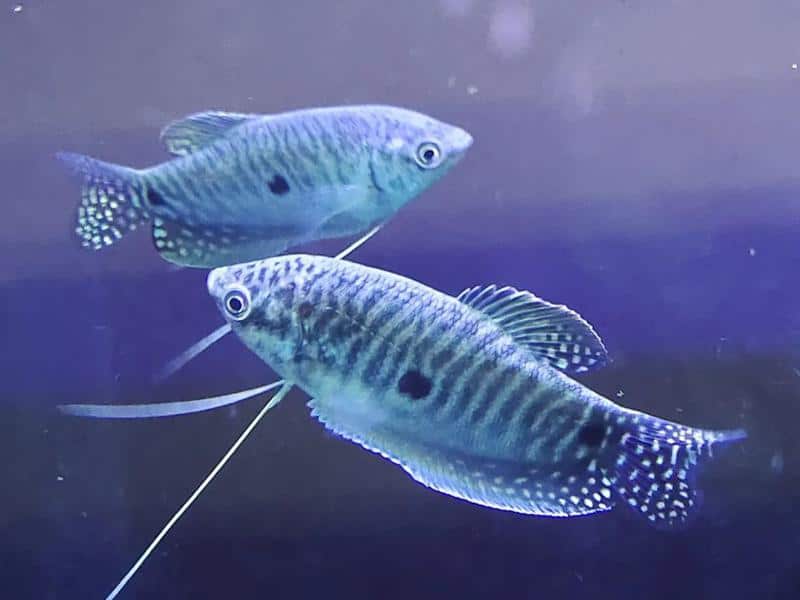
| Common Names | Opaline gourami, golden gourami, silver gourami |
| Scientific Name | Trichogaster trichopterus |
| Average Adult Size | Up to 6 inches |
| Lifespan | 4 – 5 years |
| Minimum Tank Size | 40 gallons |
| Ideal Temperatures | 72 – 82 degrees Fahrenheit |
| Ideal pH Levels | 6.2 – 8.2 |
A three-spot gourami’s body coloration can vary depending on the mood of the fish, but it generally ranges from a light blue to an iridescent silver or opaline green.
As the name suggests, there are three dark spots along the body of the fish – one on the upper part of the body, one on the midsection, and one on the caudal peduncle, or the base of the tail.
Three-spot Gouramis are a resilient species that can adapt to a variety of water conditions and temperatures. They are also omnivores and will accept a variety of foods, including flake food, pellets, freeze-dried or frozen foods, and live foods such as brine shrimp or worms.
Although they are not particularly finicky, they tend to prefer slightly acidic water with a lower pH level during the breeding season. When young, they can be kept in smaller tanks of less than 25 gallons.
However, as they mature, a tank size of at least 40 gallons will be needed to accommodate their adult size.
5. Kissing Gourami
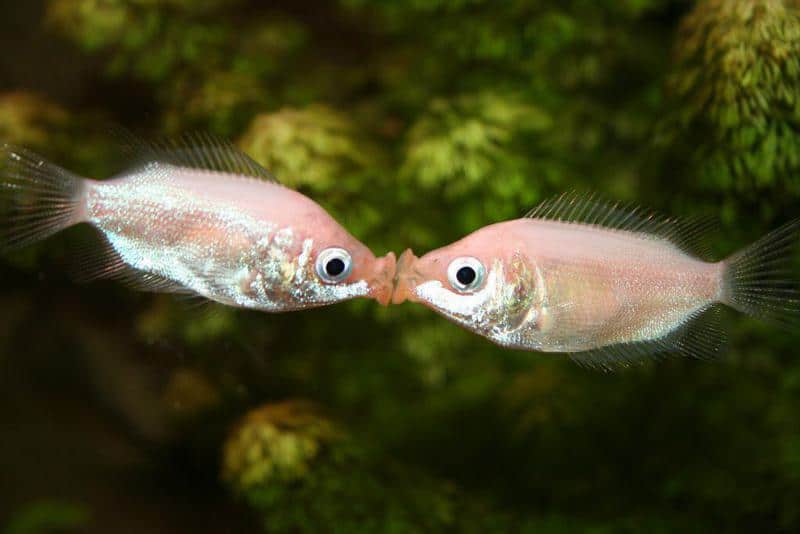
| Common Names | Kisser fish |
| Scientific Name | Helostoma temminckii |
| Average Adult Size | Up to 12 inches |
| Lifespan | 7 – 10, up to 25 years |
| Minimum Tank Size | 75 gallons |
| Ideal Temperatures | 72 – 82 degrees Fahrenheit |
| Ideal pH Levels | 6.0 – 8.0 |
The kissing gourami is the only non-Osphronemidae in the gourami fish; it belongs to the Helostomatidae family in the order of Perciformes.
It gets its name from its behavior of kissing other kisser fish; scientists say it’s a territorial behavior, but its definitive purpose is yet to be known.
It also gets its name from the shape of the mouth. The mouth has protruding lips, which give the impression that it is “kissing” other fish or objects.
The body coloration can vary depending on the mood of the fish, but it generally ranges from silver to a pale pink or peach color.
Kissing gourami is also one of the largest gouramis in the market as well as one of the oldest, with an average life expectancy of 7 – 10 years.
As for food, they are omnivores and will accept a variety of foods, including flake food, pellets, freeze-dried or frozen foods, and live foods such as brine shrimp or worms.
6. Honey Gourami
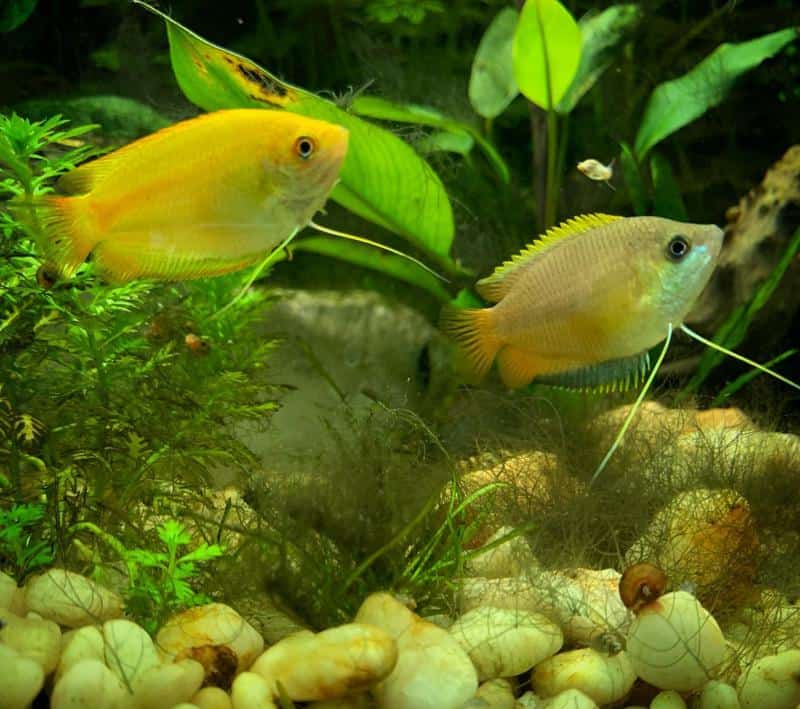
| Common Names | Sunshine gourami, Colisa chuna, Colisa sota |
| Scientific Name | Trichogaster chuna |
| Average Adult Size | Up to 3 inches, typically 2 inches or shorter |
| Lifespan | 5 – 7 years |
| Minimum Tank Size | 25 gallons |
| Ideal Temperatures | 71 – 82 degrees Fahrenheit |
| Ideal pH Levels | 6.0 – 8.0 |
The honey gourami is one of the few species confused with dwarf gouramis. This is because of the small size, making it hard to differentiate them. What distinguishes the two is the coloration and body type.
Honey gouramis have a unique coloration, with a golden-yellow body that is accented by a black, zigzag pattern on the sides. The males have more vibrant coloration than females, with bright orange or red hues on their undersides and fins. The male’s dorsal fin is elongated and pointed, while that of the female is shorter and rounded.
Honey Gouramis should be provided with a diverse diet that includes high-quality flake food and small frozen foods like daphnia and mosquito larvae to ensure proper nutrition. Interestingly, these fish have been observed to assist in eliminating the aquatic pest Hydra, particularly in aquariums infested with this pest.
7. Paradise Gourami
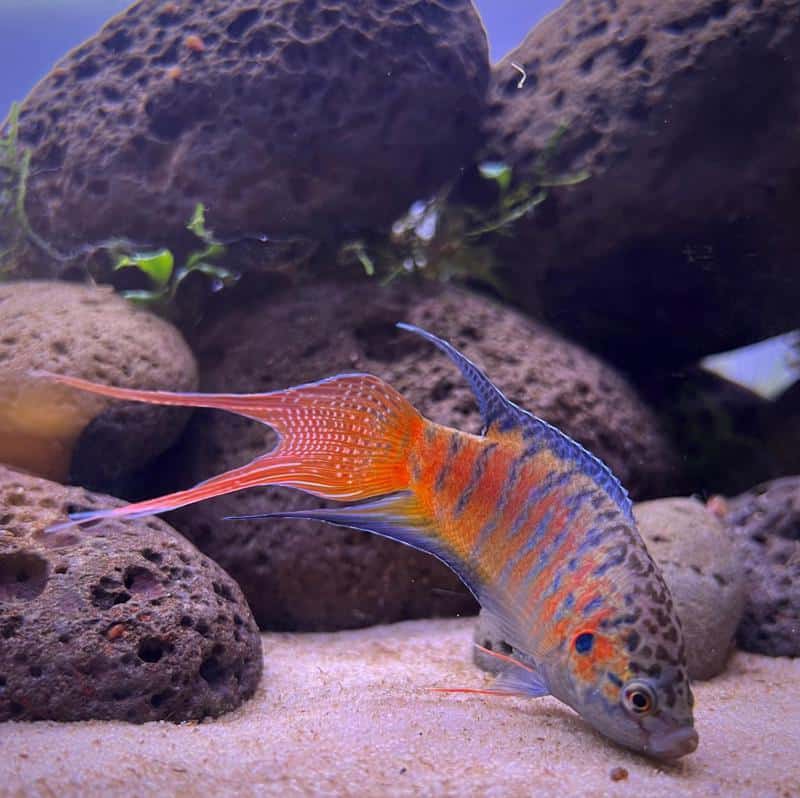
| Common Names | Paradise fish |
| Scientific Name | Macropodus opercularis |
| Average Adult Size | Up to 3 inches |
| Lifespan | 5 – 7 years |
| Minimum Tank Size | 25 gallons |
| Ideal Temperatures | 71 – 82 degrees Fahrenheit |
| Ideal pH Levels | 6.0 – 8.0 |
Native to East Asia, the paradise gourami was among the first ornamental fish to be imported across the world from the 1860s till the late 1800s.
It is unique in the gourami family because it is the most aggressive gourami. The aggression is usually directed towards other paradise fish rather than other species. As much as its aggression may be a downside to many, it is also the cause of its popularity.
The paradise fish changes its color often whenever it gets into a fight or gets challenged. It is among the very few fish in the world that can change their color due to a stimuli response.
The body coloration ranges from a light greenish-brown to an iridescent silver or gold. Get this gorgeous species to see it display dark blue lateral lines on its body as it extends its fin during a fight.
8. Snakeskin Gourami
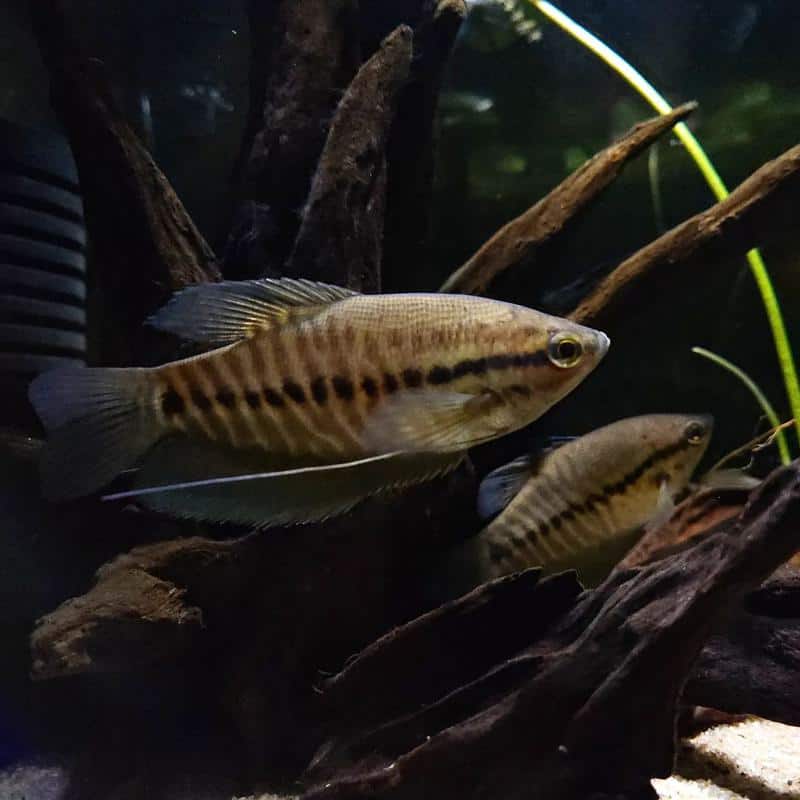
| Scientific Name | Trichopodus pectoralis |
| Average Adult Size | 5 – 10 inches |
| Lifespan | 5 – 8 years |
| Minimum Tank Size | 35 gallons |
| Ideal Temperatures | 75 – 82 degrees Fahrenheit |
| Ideal pH Levels | 6.0 – 7.5 |
Named for its coloration, the snakeskin gourami has a yellow or gold base color on the body that is accented with dark, irregular stripes and spots that resemble a snakeskin pattern.
It has a slender, slightly flattened body and a small dorsal fin. Its anal fin is almost as long as its body, and its pelvic fins are long and thin, resembling threads.
It is a big gourami species but is highly sort out for because of its mesmerizing snake skin. People also like it because it is a great source of food, often sold as fish food in its native regions of Southeast Asia, including Thailand, Cambodia, and Vietnam.
The Snakeskin Gourami is a peaceful fish species that can be kept in a community aquarium with other small and peaceful fish species. They are not aggressive and will typically get along with other non-aggressive fish.
However, it is recommended to keep only one male per aquarium to avoid aggression between males.
9. Moonlight Gourami
| Common Names | Moonbeam gourami |
| Scientific Name | Trichopodus microlepis |
| Average Adult Size | Up to 6 inches |
| Lifespan | 4 – 6 years |
| Minimum Tank Size | 30 gallons |
| Ideal Temperatures | 79 – 86 degrees Fahrenheit |
| Ideal pH Levels | 6.0 – 7.0 |
Moonlight gourami is another relatively larger gourami species that can grow taller than 5 inches in ideal conditions. It gets its name from a distinctive black spot located behind the gills that are shaped like a crescent moon.
The coloration is attractive, too, with a silver/pearl base color on the body that shimmers with iridescent blue/green hues under proper lighting.
The Moonlight Gourami prefers a planted aquarium with plenty of hiding places and moderate water flow. They are omnivores and will accept a variety of foods, including flake food, pellets, freeze-dried or frozen foods, and live foods such as brine shrimp or worms.
10. Sparkling Gourami
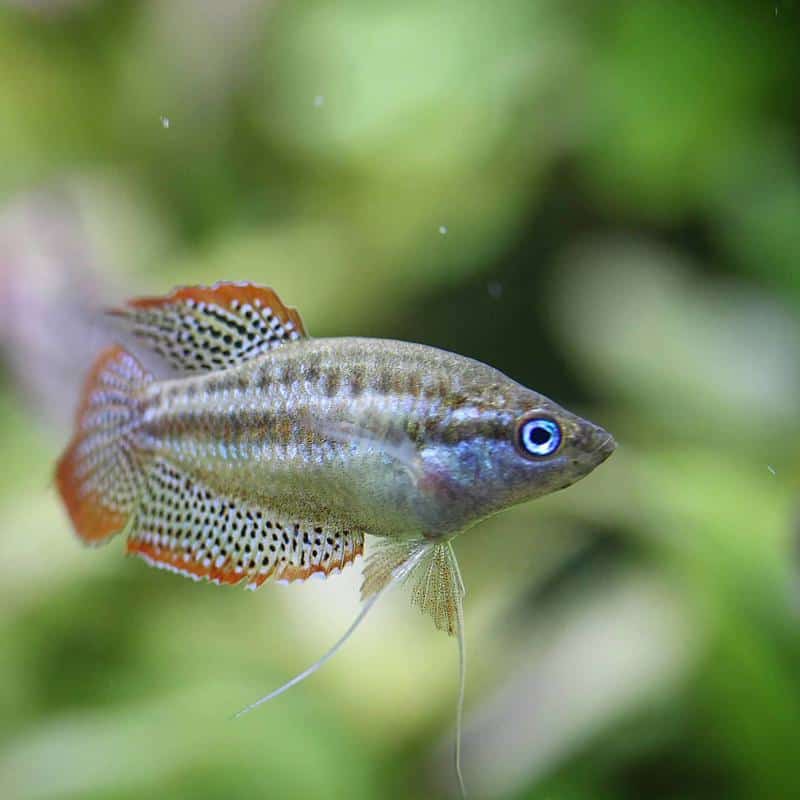
| Common Names | Pigmy gourami |
| Scientific Name | Trichopsis pumila |
| Average Adult Size | Up to 1.5 inches |
| Lifespan | 2 – 5 years |
| Minimum Tank Size | 15 gallons |
| Ideal Temperatures | 76 – 82 degrees Fahrenheit |
| Ideal pH Levels | 6.0 – 7.0 |
These small gouramis that typically grow up to 1 inch are a great option for those who want a huge school of fish. The best group of sparkling/pigmy fish consists of four or more; if you want 20 pigmy fish in one tank, then go for it.
It is nicknamed the pigmy because of its tiny size but is also called the sparkling gourami owing to its ‘sparkling’ colors. It has a base color of silver or light blue and iridescent green or blue stripes running vertically along the body. The fins are transparent with a slight hint of blue or green.
Pigmy gouramis are other bubble nesters. The male will build a bubble nest on the surface of the water and will court the female by swimming in circles around her.
Once the female lays her eggs, the male will collect them and place them in the bubble nest, where he will guard them until they hatch in 24-48 hours.
Sparkling gouramis are omnivores and will accept a variety of foods, including flake food, pellets, freeze-dried or frozen foods, and live foods such as brine shrimp or worms.
Read More:
- Types of Barb Fish
- Most Popular & Beautiful Tang Fish Types
- Aquarium Catfish Types
- Types of Oscar Fish
Frequently Asked Questions
What’s the Most Peaceful Gourami?
All gouramis are peaceful, but male gourami tank mates can get quite aggressive when next to each other. To get the most peaceful gourami community, you should opt for a female-only tank.
What Is the Easiest Gourami to Keep?
The easiest gourami to care for depends on your experience and expertise. However, you will not have a lot of work keeping smaller gourami types like the dwarf gouramis. They are low-maintenance, hardy, and quite peaceful to keep around.
How Many Gouramis Should Be Kept Together?
Gouramis thrive in groups of 3 – 10. However, this varies from one type to another. The best groups depend on how many gouramis you can keep in your particular fish tank.
It is easy to keep ten dwarf gouramis in a single tank, but it is much harder for bigger gouramis like the three-spot and giant gouramis that grow past 5 inches. A rule of thumb is groups of 10 for small gouramis and groups of 3 for large ones.
Conclusion
Any type of gourami is fit for an enthusiastic aquarist. They are peaceful creatures with lovely colors and exciting behaviors that make them a blast to have in your tank.
Their prices are also favorable, and due to their popularity, you will never lack any help from the huge communities built around these gorgeous species.
